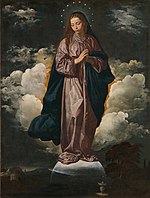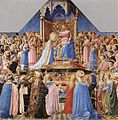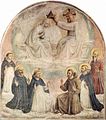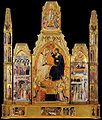Queen of Heaven
Queen of Heaven is a title given to the Blessed Virgin Mary by Christians, mainly Catholics and Orthodox, to whom the title is a consequence of the Council of Ephesus, where the Virgin Mary was proclaimed Mother of God. It is also the name used by the prophet Jeremiah probably in reference to Asherah a goddess worshipped in ancient Israel and Judah (see Book of Jeremiah, 7:18 and 44:17).
Orthodox and Catholic Christians also believe that Mary was assumed into heaven, which is a dogma in the Catholic Church since 1950.
Catholic dogma states that Mary is in heaven, the Immaculate Mother of God, the ever Virgin Mary, having completed the course of her earthly life, was assumed body and soul into heavenly glory[1] The title Queen of Heaven has been a Catholic tradition, included in prayers and devotional literature, and seen in Western art in the subject of the Coronation of the Virgin, from the High Middle Ages, long before it was given formal status by the Church. It was included by Pope Pius XII in his encyclical about the Queen of Heaven, Ad Caeli Reginam. [2] For centuries, Catholics, while reciting the Litany of Loreto were calling on Mary as queen of heaven.
The Eastern Orthodox Church does not share the Catholic dogma, but has itself a rich liturgical history (hymns, sermons, icons). The themes include the annunciation of Mary's transition into heaven through angels, the gathering of apostles around the dying virgin Mary, the funeral procession, the empty tomb and, Mary in heaven. [3] The Orthodox also have a history of devotional beliefs, many of which originate in the Liber de Transitu Mariae (Book of the transition of Mary) dating to the end of the fourth century [4]
Early Protestantism and leading reformers such as Martin Bucer, Johannes Brenz and Bullinger accept Mary's existence in heaven as self-evident as a matter of faith. [5] Johannes Oecolampadius considers Mary as neck of the Mystical Body of Christ and Queen of all Heavely Powers [6] Martin Luther, in a 1522 sermon at the Feast of the Assumption of Mary, states that she is there, but refuses to discuss how she got there, because of an absence of scriptural proof. [5] In the following theological developments within Protestantism, Marian veneration was largely rejected. Mariology, "a foreign object to Protestant theology, became a means of teaching differences. [7] In the light of this context, the question of Mary as Queen of Heaven was not even raised.
Queen of Heaven is a title of Mary, which stimulated veneration expressed in theology, literature and liturgies such as the Liturgy of the Hours, music and art. Since the Council of Ephesus, pictoral presentation of Mary were encouraged, which resulted in numerous presentations of Mary as Regina throughout the ages. Cities in Italy and elsewhere proclaimed the Queen of Heaven to be Queen of Siena, Massa Marittima, San Gimignano but also the State of Bavaria [8]
Benedict XVI noted that Mary's acceptance of the divine will is the ultimate reason, she is Queen of Heaven. Because of her humble and unconditional acceptance of God's will "God exalted her over all other creatures, and Christ crowned her Queen of heaven and earth." [9]
Catholicism

According to Catholic doctrine, Mary was assumed into heaven and is with Jesus Christ, her divine Son. Mary should be called Queen, not only because of her Divine Motherhood of Jesus Christ, her only Son, but also because God the Father has willed her to have an exceptional role in the work of the eternal salvation of humanity. The encyclical argues that as Christ, because he redeemed humankind, is its Lord and king by a special title, so the Blessed Virgin Mary is Queen, on account of the unique manner in which she assisted in the redemption of humanity by giving of her own substance, by freely offering him by her singular desire and petition for, and active interest in, human salvation.[10]
Quotes:
- From the earliest ages of the Catholic Church, a Christian people, whether in time of triumph or more especially in time of crisis, has addressed prayers of petition and hymns of praise and veneration to the Queen of Heaven. And never has that hope wavered which they placed in the Mother of the Divine King, Jesus Christ; nor has that faith ever failed by which we are taught that Mary, the Virgin Mother of God, reigns with a mother's solicitude over the entire world, just as she is crowned in heavenly blessedness with the glory of a Queen. [11]
- Mary was chosen as Mother of Christ in order that she might become a partner in the redemption of the human race; As Christ, the new Adam, must be called a King not merely because He is Son of God, but also because He is our Redeemer, so, analogously, the Most Blessed Virgin is queen not only because she is Mother of God, but also because, as the new Eve, she was associated with the new Adam. [12]
Mariological basis
Queen of Heaven (Latin Regina Caeli) is one of many Queen titles used of the Virgin Mary. The title derived in part from the ancient Catholic teaching that Mary, at the end of her earthly life, was bodily and spiritually assumed into heaven, and that she is there honored as Queen. [13]
The first Mariological definition and basis for the title of Mary Queen of Heaven developed at the Council of Ephesus, where Mary was defined to be the Mother of God. The Council fathers specifically approved this version against the opinion, that Mary is "only" the mother of Jesus. Nobody had participated in the life of her son more, than Mary, who gave birth to the Son of God. [14]
[edit] Litany of Loreto
The Litany of Loreto includes several supplications to Mary as Queen. There are two types of statements about the Queen of Heaven.
- Some refer to the Virgin Mary as theological statements about her queenship.
- Others indicate more specifically her realm of influence of the virgin as queen of heaven.
Queen conceived without original sin
Queen conceived without original sin refers to the Immaculate Conception of the Virgin Mary, a long held belief which became dogma in 1854. It definitively solved the question, how Mary, fully human and in need of redemption like everybody else, was granted the fullness of God's grace from her very beginning. The dogma teaches, that Mary, the Mother of God, participated from before her birth in the holiness of God through his grace. She did not become a goddess but being without sin, the spiritual mother and new Eve.[15]
Queen assumed into Heaven
This is the reason she is Queen assumed into Heaven. To Catholics, assumption into heaven refers to the elevation into the heavenly realm, where the saints are with God and his son. [15] Queen assumed into heaven is thus an indication, that Mary's service to the human race was not concluded with the birth of Christ, but continues for all eternity in heaven.[15]
Queen of the Rosary,
As Queen of the rosary, Mary lets the faithful participate in her life with Christ [16] The rosary is a prayer for faith, hope and love, who were all perfected in the Virgin Mary.
Queen of Peace
To Christians Christ is peace. They pray: "May the peace of Christ be with you" Mary is Queen of Peace, because she aided in the reconciliation of humanity with God like nobody else. With the fullness of her person she aided the entry of peace into this world. She is also considered Queen of Peace, because throughout her life, she lived by his will and not her own. Peace in the Catholic tradition means to do his will. [15]
Queen of the Angels
In the Catholic tradition as reflected in the Litany of Loreto, angels are messengers of God; angels also praise God, As Mother of God, Mary is more than a messenger and nobody praised him more than Mary in her Magnificat. In the heavenly kingdom Mary is therefore Queen of the Angels,
Queen of the Patriarchs
In the Old Testament, patriarchs have a exceptional relation to God. Abraham is even seen as father of the faith (Gen15,5 Rom 4 Hebr 11,8) In the Litany of Loreto, God is not only the God of Abraham, Isaac and Jacob, but also the God of Mary. Only Mary had the complete faith for which she was considered blessed (Luke 1,45) [15] With the title Queen of Patriarchs, the Catholic Church states the continued relevance and position of the Patriarchs of the Old Testament.
Other titles
For similar reasons, Mary, because her prophetic pronouncements in the Magnificat is Queen of Prophets. She is Queen of Apostles, Queen of Martyrs, Queen of Confessors, Queen of Virgins, and Queen of all Saints .[17] As Ever Virgin and immaculate Mother of God assumed into heaven, she is closer to God than any other creature [15]
Feast of Queenship
Queenship of Mary is a Marian feast day in the liturgical calendar of the Roman Catholic Church, created by Pope Pius XII. On 11 October 1954, the Pontiff pronounced the new feast in his encyclical Ad caeli reginam. The feast was celebrated on May 31, the last day of the Marian month. In 1969, Pope Paul VI moved the feast day to August 22.
The movement to officially recognise the Queenship of Mary was initially promoted by several Catholic Mariological congresses in Lyon France, Freiburg Germany, and Einsiedeln Switzerland. Gabriel Roschini founded in Rome, Italy, an international society to promote the Queenship of Mary, Pro Regalitate Mariae. [18] Several Popes had described Mary as Queen and Queen of Heaven, which was documented by Gabriel Roschini. Pope Pius XII repeated the title in numerous encyclicals and Apostolic Letters, especially during World War II [19] [20] [21] [22] [23] [24] [25]
Veneration
The Catholic faith states as a dogma, that Mary is assumed into heaven, and is with Jesus Christ, her divine son. Mary should be called Queen, not only because of her Divine Motherhood of Jesus Christ, but also because God has willed her to have an exceptional role in the work of eternal salvation. The encyclical Ad Caeli Reginam argues, that Christ as redeemer is Lord and King. The Blessed Virgin is Queen, because of the unique manner in which she assisted in our redemption, by giving of her own substance, by freely offering Him for us, by her singular desire and petition for, and active interest. [26] Mary was chosen Mother of Christ so she might become a partner in the redemption of the human race; The Catholic Church always venerared the queen of Heaven, according to Pius XII:as
- From the earliest ages of the Catholic Church a Christian people, whether in time of triumph or more especially in time of crisis, has addressed prayers of petition and hymns of praise and veneration to the Queen of Heaven And never has that hope wavered which they placed in the Mother of the Divine King, Jesus Christ; nor has that faith ever failed by which we are taught that Mary, the Virgin Mother of God, reigns with a mother's solicitude over the entire world, just as she is crowned in heavenly blessedness with the glory of a Queen. [27]
Queen of Heaven in the Liturgy of the Hours
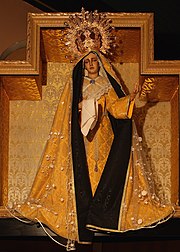
There are four ancient Marian antiphones, which express the queenship of the Virgin Mary. They are prayed daily in different times of the year as a part of the Liturgy of the Hours. Salve Regina, Ave Regina Caelorum, Alma Redemptoris Mater, and, Regina Caeli.
Salve Regina
The Queen of Heaven is praised in the Salve Regina (Hail Queen), which is sung in the time from Trinity Sunday until the Saturday before the first Sunday of Advent. In the vernacular as a prayer to the Virgin Mary, the Hail Holy Queen is the final prayer of the Rosary. A German Benedictine monk Hermann of Reichenau (1013-1054) allegedly composed it, and originally it appeared in Latin, the prevalent language of the Catholic Church until Vatican II. Traditionally it has been sung in Latin, though many translations exist. These are often used as spoken prayers. In the Middle Ages, Salve Regina offices were held every Saturday [28] In the 13th century, the custom developed, to greet the Queen of Heaven with the Salve Regina, which is considered the oldest of the four Marian antiphons. Several Protestant reformes strongly objected to the Salve and the title Queen of Heaven. As a part of the Catholic Reformation, the Salve Regina was prayed every Saturday by members of the Sodality of Our Lady, a Jesuit Marian congregation.
Ave Regina Caelorum
Ave Regina Caelorum (Hail, Queen of Heaven) is a early Marian antiphon, praising Mary, the Queen of Heaven It is traditionally said or sung after each of the canonical hours of the Liturgy of the Hours. The prayer is used especially after Compline, the final canonical hour of prayer before going to sleep. It is said from the Feast of the Presentation (February 2) through Wednesday of Holy Week. It used to be sung at the feast of the Assumption of Mary. Ave Regina Caelorum dates back in a different musical intonation to the 12th century. [29] Today's version is slightly different from a 12th century intonation. The Ave Regina Caelorum has four parts: Ave, Salve, Gaude and Vale ( in English: Hail rejoice, farewell). It was used for processions in honour of the Queen of Heaven. [30] Ave Regina Caelorum received numerous musical versions, a famous of which was composed in 1773 by Joseph Haydn.[31]
Alma Redemptoris Mater

Alma Redemptoris Mater ("Loving Mother of our Savior) ", is recited in the Catholic Church at compline only from the first Sunday in Advent until the Feast of the Purification (February 2. Continuing theological discussions exist, as to the origin and excaxt timing of this Marian antiphon. It has two equal parts. The Virgin Mary is loving Mother of the Savior, ever virgin with a very high position in heaven. May she listen to her people with mercy in their need for her help.Alma Redemptoris Mater, [32] The Latin text is rather short:
-
- Alma Redemptoris Mater, quae pervia caeli,
- Porta manes, et stella maris, succurre cadenti,
- Surgere qui curat, populo: tu quae genuisti,
- Natura mirante, tuum sanctum Genitorem
- Virgo prius ac posterius, Gabrielis ab ore
- Sumens illud Ave, peccatorum miserere.
Regina Coeli
Regina Coeli (Queen of Heaven) is an anthem of the Roman Catholic Church which replaces the Angelus at Eastertide (from Holy Saturday until the Saturday after Pentecost); it is named for its opening words in Latin. Regina Coeli was subject of numerous intonations throughout the centuries by known and unknown composers. Not all attributions are correct however, as an often quoted Regina Coeli by Joseph Haydn had other authors. [31] Of unknown authorship, the anthem was in Franciscan use in the first half of the 13th century. Together with three other Marian anthems, it was incorporated in the Minorite Roman Curia Office, which the Franciscans soon popularized everywhere, and which by order of Pope Nicholas III (1277–1280) replaced all the older breviaries in the churches of Rome. [33]
Biblical Basis

The term "queen of heaven" does appear in the Bible but is not a reference to Mary. In the Old Testament the prophet Jeremiah writing circa 628 BC refers to a "queen of heaven" in chapters 7 and 44 of the Book of Jeremiah. This title was probably given to Asherah a Caananite idol and goddess worshipped in ancient Israel and Judah.[34] For a discussion of "queen of heaven" in the Old Testament, please see Queen of heaven (Antiquity).
In the New Testament, the title has several biblical sources. Mary is mother of the messianic king. Luke 1:32 says of Jesus, He will be great, and will be called the Son of the Most High; and the Lord God will give to him the throne of his father David. He will rule over the house of Jacob forever and his reign will be without end. It is therefore held in Christianity, that the throne of King David has passed to Jesus. The biblical precedent of ancient Israel is that the mother of the king becomes the Queen Mother. Since Jesus is heavenly king, of the lineage of David and Solomon, many see Mary as Queen Mother.
The Roman Catholic Church also sees Mary crowned as queen in heaven in the Book of Revelation 12, verses 1-5: "1 A great and wondrous sign appeared in heaven: a woman clothed with the sun, with the moon under her feet and a crown of twelve stars on her head. 2 She was pregnant and cried out in pain as she was about to give birth. 3 Then another sign appeared in heaven: an enormous red dragon with seven heads and ten horns and seven crowns on his heads." For Catholics, the reference to the ark of the covenant immediately prior to this passage(chapter 11, verse 19)confirms the woman's identification with Mary as she is seen as the ark of the "new covenant" bearing the Word of God (Christ) in her womb as the old ark carried the Ten Commandments. Catholics interpret Psalm 45, "A Song Celebrating the King's Marriage", refers to the Messiah, to suggest in verse nine, that Jesus, the Messiah, would have a queen at his right hand. Although Mary was Jesus' mother, she is often portrayed as that queen. Other views are that Psalm 45 refers to the marriage of Jesus to His people -- i.e., the church which is called the "Bride of Christ" or that Psalms 45 is simply a celebration upon the marriage of an earthly king, giving thanks to God but not referring to the Messiah. It is also believed by those assigning a special significance to Mary, and believing in her Annunciation, that in Luke 1:26-35 of the New Testament the Archangel Gabriel seems to praise Mary, although she would otherwise be inferior to him.
The Catholic Church generally reasons, that the bible speaks of the mother of Jesus as: "a woman clothed with the sun, and the moon under her feet, and on her head a crown of twelve stars" - (Revelation 12:1). As Mary is a perfect model of the Church, this woman also represent the Church as a whole. [35] However, non-Catholic Bible scholars interpret these verses to be not referring to Mary, but rather to Israel or Judah. Bible generally refers nations and tribes to female characters like in Matthew 2:18 & Revelation 17. And since Jesus is the Alpha and Omega(Revelation 22:13) and through Him all things were created(Colossians 1:15-17), Mary is not considered to be the Queen of Heaven. This is still a controversial subject in Christianity, not accepted by all denominations.
Queen of Heaven in art
Early Christian art show Mary in an elevated position. She carries her devine son in her hands, or holds him. After he ascended into heaven, he reigns in devine glory. Mary, his mother, assumed into heaven by her son, participates in his heavenly glory. The Second Council of Nicaea decreed, that such pictures of Mary should be venerated. [36] Protestant reformers discouraged Marian art, some like John Calvin or Zwingli even encouraged its destruction.
After the Council of Trent, which confirmed the veneration of Marian paintings, Mary was often painted as a Madonna with crown, surrounded by stars, standing on top of the world or the partly visible moon. After the victory against the Turks at Lepanto, Mary is depicted as the Queen of Victory, sometimes wearing the crown of the Habsburg empire. [37] National interpretations existed in France as well, where Jean Fouquet painted the Queen of Heaven in 1450 with the face of the mistress of King Charles VII [8] Statues and pictures of Mary were crowned by kings in Poland, France, Bavaria, Hungary and Austria,[8] sometimes apparently using crowns previously worn by earthly monarchs - a surviving small crown presented by Margaret of York seems to have been that worn by her at her wedding to Charles the Bold in 1463. A recent coronation was that of the picture of the Salus Populi Romani in 1954 by Pius XII. The veneration of Mary as queen continues into the 21st Century, but artistic expressions do not have the leading role as in previous times[38]
Artworks, including paintings, mosaics and carvings of the coronation of Mary as Queen of Heaven, became increasingly popular from the 13th century onward. Works follow a set pattern, showing Mary kneeling in the heavenly court, and being crowned either by Jesus alone, or else by Jesus and God the Father together, with the Holy Spitit, usually in the form of a dove, completing the Trinity. The Coronation of Mary is almost entirely a theme of western art. In the Eastern Orthodox Church, although Mary is often shown wearing a crown, the coronation itself never became an accepted artistic subject.
Gallery of art
Paintings
| Martino di Bartolomeo, 1400 | Crowning of the Virgin by Rubens, 17th century | Velázquez, Crowning of the Virgin, 1645 | Gregorio di Cecco Enthroned Madonna |
| Crowned Madonna Della Strada | Lorenzo Monaco, Coronation, 1414, Uffizi, Florence | Botticelli, with only God the Father in evidence | |
| Pietro Perugino, 1504 | Raphael, 1502-1504 | Giacomo di Mino, 1340-1350 | Giulio Cesare Procaccini, 17th century |
| Fra Angelico with a larger court setting | Lorenzo Costa, Crowning of the Madonna and saints, 1501 | Tetmajer Modonna in Heaven, 1895 | Botticelli, with only God the Father, 15th century |
| Lorenzo Costa, Crowning of the Madonna and saints, 1501 | Coronation, Agnolo Gaddi, 14th century | Jean Fouquet, Coronation of the Virgin, 15th century | Coronation of the Virgin by Filippo Lippi|, 1441 |
| Paolo Veneziano, 1324 | Ridolfo Ghirlandaio, 1504 | Gentile da Fabriano, 1422-1425 | Fra Angelico, 1434-1435 |
Statues
| Crowned statue of Our Lady of San Juan de los Lagos, with two angles | Crowned statue in Porto Alegre, Brazil | Crowned Virgin with Rosary, Varallo Sesia, Italy | Crowned statue of the Blessed Virgin, Spain |
Frescoes
| Tetmajer Modonna in Heaven, 1895 | Scheffler, Queen of Heaven, Regensburg, Germany | Scheffler, Crowned Virgin | El Escoral Monastery Spain |
| Fra Angelico, Florence, 1437-1446 | Church of Sant'Angelo, Milan | Salzburg, 1697–1700 | Aldo Locatelli, 20th century, Brazil |
Altars
| Coronation of the Virgin, Bartolo di Fredi, 1388 | Gentile da Fabriano Altarpiece | Altar in Ansbach | |

